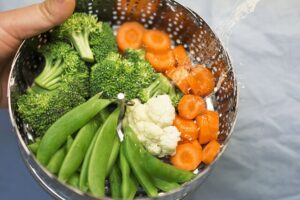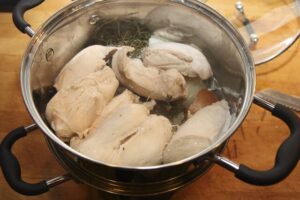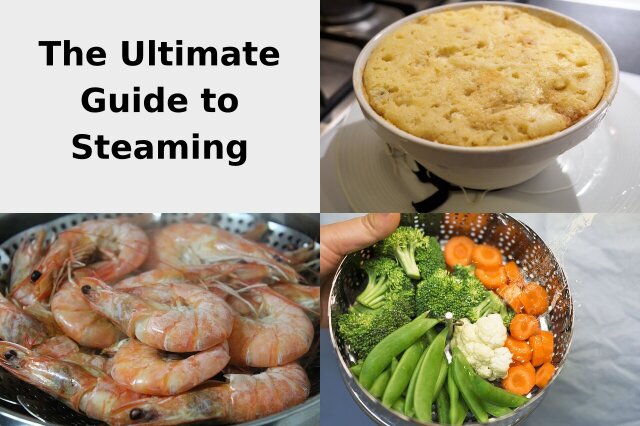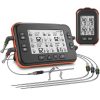Steaming is a versatile cooking method that not only preserves the nutritional value of ingredients but also enhances their natural flavours.
Whether you’re a seasoned chef or a beginner in the kitchen, this guide will provide you with all the tips, tricks, and recipe inspiration you need to master the art of steaming.
In this comprehensive guide, we’ll delve into the various types of steamers available, from bamboo steamers to electric steamers, and help you choose the right one for your needs.
We’ll also walk you through the step-by-step process of steaming, sharing essential tips and techniques for perfect results every time.
From steaming vegetables to fish, dumplings to desserts, our guide will offer a wide range of recipes to satisfy your cravings and impress your guests.
Get ready to discover the benefits of steaming, learn how to infuse flavours into your dishes, and experiment with exciting new ingredients.
So grab your favourite steamer and let’s embark on a culinary journey that will take your cooking skills to new heights. Are you ready to steam your way to deliciousness? Let’s get started!
Benefits of steaming.
Steaming is a cooking method that offers numerous benefits.
- Firstly, it preserves the nutritional value of ingredients by cooking them gently and without the need for excessive oil or fat.
- Secondly, steaming enhances the natural flavours of ingredients.
By cooking food in its own steam, you ensure that the flavours remain intact, resulting in a more vibrant and delicious end product.
- Lastly, steaming is a versatile and convenient cooking method.
Whether you’re steaming vegetables, fish, or even desserts, the process is relatively quick and requires minimal preparation.It’s also a healthier alternative to frying or sautéing, making it an excellent choice for those looking to maintain a balanced diet.
Steaming vegetables, for example, helps retain vitamins and minerals that can be lost through other cooking methods.
Different methods of steaming.
When it comes to steaming, there are several methods you can choose from, depending on your preferences and the equipment you have available.
The most common methods include stovetop steaming, bamboo steaming, and electric steaming.
- Stovetop steaming:
- Stovetop steaming is a traditional method that involves using a pot with a steamer insert.
This method is great for steaming larger quantities of food and allows for more control over the cooking process.Simply place the food in the steamer basket, add water to the pot, and bring it to a simmer.
- Bamboo steaming:
- Bamboo steaming, on the other hand, is a popular method in Asian cuisine.
It involves using a bamboo steamer stacked on top of a pot of boiling water.The bamboo steamer absorbs excess moisture, preventing it from dripping onto the food.
This method is ideal for steaming dumplings, buns, and other delicate foods.
- Electric steaming:
- Electric steamers are another convenient option for steaming.
They come in various sizes and often have multiple compartments, allowing you to steam different foods simultaneously.Electric steamers are easy to use and require minimal monitoring, making them a great choice for busy individuals.
How to choose the right steaming equipment.
Choosing the right steaming equipment is essential for achieving the best results.
Consider the following factors when selecting a steamer:
- Size:
- Determine the quantity of food you typically need to steam and choose a steamer that can accommodate that amount.
If you often cook for a large family or enjoy hosting dinner parties, opt for a larger steamer with multiple compartments.
- Material:
- Steamers can be made from various materials, including stainless steel, bamboo, and silicone. Each material has its own advantages, so consider factors such as durability, heat conductivity, and ease of cleaning when making your decision.
- Features:
- Electric steamers often come with additional features, such as timers and preset cooking programs.
Consider whether these features would be beneficial for your cooking needs.
- Budget:
- Steamers come in a range of prices, so set a budget and look for options within that range. Remember that investing in a high-quality steamer can make a significant difference in the long run.
By considering these factors, you’ll be able to choose a steamer that suits your specific needs and enhances your steaming experience.
Steaming tips for beginners.
If you’re new to steaming, don’t worry! We have some essential tips to help you get started on your steaming journey.
- Use the right amount of water:
- When steaming, it’s important to use the correct amount of water to create steam.
Too little water can cause the pot to dry out, while too much water can lead to soggy food.
Follow the instructions provided with your steamer to determine the appropriate water level.
- Prepare ingredients properly:
- To ensure even and thorough steaming, it’s important to prepare your ingredients properly.
Cut vegetables into even-sized pieces, marinate meats for added flavour, and season your dishes with herbs and spices.
- Arrange food strategically:
- When steaming multiple ingredients, arrange them strategically to ensure even cooking.
Place denser and thicker items at the bottom and delicate items on top.
This allows the steam to circulate evenly and cook everything to perfection.
- Avoid opening the steamer unnecessarily:
- Opening the steamer during the cooking process can cause a loss of heat and steam, resulting in uneven cooking.
Only open the steamer when necessary to check the doneness of your food.
- Let food rest after steaming:
- After removing your food from the steamer, allow it to rest for a few minutes.
This helps to lock in the flavours and ensures that the food is cooked evenly throughout.
By following these tips, you’ll be well on your way to becoming a steaming pro in no time.
Steaming vegetables:
Best practices and recipe ideas.

Best practices and recipe ideas.
Steaming vegetables is a fantastic way to retain their vibrant colours, crisp textures, and nutritional value.
Here are some best practices and recipe ideas for steaming vegetables:
- Choose the right vegetables:
Not all vegetables are suitable for steaming.
Opt for vegetables with a high water content, such as potato, broccoli, cauliflower, carrots, and green beans.Leafy greens like spinach and kale can also be steamed, but they require less cooking time.
- Cut vegetables into uniform sizes:
To ensure even cooking, cut your vegetables into uniform sizes.This allows them to steam at the same rate, resulting in a perfectly cooked dish.
- Season your vegetables:
While steaming vegetables helps to retain their natural flavours, you can enhance them by adding seasoning.Toss your veggies with olive oil, salt, pepper, and your favourite herbs and spices before steaming.
- Steam vegetables Al Dente:
Avoid overcooking your vegetables, as they can become mushy and lose their vibrant colours.Steam them until they are just tender, with a slight crunch.
Now that you have some best practices in mind, let’s explore some delicious recipe ideas for steaming vegetables:
- Steamed Broccoli with Garlic and Lemon:
- Toss broccoli florets with minced garlic, lemon zest, and a drizzle of olive oil.
Steam until the broccoli is tender-crisp, then squeeze fresh lemon juice over the top before serving.
- Steamed Carrots with Honey Glaze:
- Steam sliced carrots until they are tender, then drizzle them with a mixture of honey, melted butter, and a pinch of cinnamon.
Serve as a side dish or add them to a salad for extra sweetness.
- Steamed Green Beans with Sesame Dressing:
- Steam green beans until they are bright green and crisp.
Toss them with a homemade sesame dressing made from sesame oil, soy sauce, rice vinegar, and a touch of honey.
Experiment with different vegetables and seasonings to create your own flavour combinations.
Steaming vegetables not only provides a healthy and delicious side dish but also allows you to get creative in the kitchen.
Steaming seafood:
Techniques and flavour combinations.

Techniques and flavour combinations.
Here are some techniques and flavour combinations to try:
- Choose fresh seafood:
When it comes to steaming seafood, freshness is key.
Look for fish, shrimp, or shellfish that has a mild aroma and firm flesh.Freshness ensures that your seafood will have a tender and succulent texture.
- Marinate seafood for added flavour:
Before steaming, Marinate your seafood in a flavourful mixture to enhance its taste.A simple marinade of soy sauce, ginger, garlic, and a splash of sesame oil works well for most seafood.
- Steam seafood on a bed of aromatics:
To infuse additional flavour into your seafood, steam it on a bed of aromatics such as sliced lemons, ginger, and herbs.This imparts a subtle fragrance and enhances the overall taste.
- Pair seafood with complementary flavours:
When serving steamed seafood, consider pairing it with complementary flavours.For example, steamed fish goes well with a tangy citrus sauce, while steamed shrimp can be dipped in a spicy cocktail sauce or served with a creamy garlic aioli.
Now, let’s explore some delicious steamed seafood recipes:
- Steamed Salmon with Soy Ginger Glaze:
- Marinate salmon fillets in a mixture of soy sauce, grated ginger, minced garlic, and a touch of honey.
Steam until the salmon is cooked through and flaky.
Serve with steamed vegetables and drizzle the remaining marinade over the top.
- Steamed Mussels in White Wine Broth:
- Steam fresh mussels in a flavourful broth made from white wine, garlic, shallots, and a splash of cream.
Serve with crusty bread to soak up the delicious broth.
- Steamed Shrimp with Spicy Chili Sauce:
- Steam shrimp until they are pink and opaque.
Serve with a homemade spicy chili sauce made from chili paste, lime juice, garlic, and a touch of sugar.
Remember to adjust the steaming time based on the thickness of your seafood. Overcooked seafood can become rubbery, so keep a close eye on the cooking process.
Steaming meats and poultry:
Cooking times and flavour tips.

Cooking times and flavour tips.
Here are some cooking times and flavour tips to ensure perfect results:
- Choose the right cuts of meat:
When steaming meats and poultry, choose cuts that are suitable for this cooking method.Lean cuts like chicken breasts, pork tenderloin, and fish fillets work well.
Avoid using fatty cuts, as they can become greasy when steamed.
- Season and marinate for extra flavour:
Before steaming, season your meats and poultry with salt, pepper, and your favourite herbs and spices.Marinating them for a few hours or overnight can also add depth and complexity to the flavours.
- Use a meat thermometer for precise cooking:
Steaming meats and poultry requires precise cooking times to ensure they are cooked through but still tender and juicy.Invest in a meat thermometer to accurately gauge the internal temperature.
Why You Should Use a ChefsTemp Thermometer When Cooking
A ChefsTemp thermometer is an essential tool for any cook or baker.
It allows you to monitor the internal temperature of your food more accurately, which helps you achieve consistent results and perfect textures.Additionally, it can be used to make sure that food has reached safe temperatures, ensuring that it's safe to eat.
Unlike other thermometers, the ChefsTemp reads quickly and accurately in both Celsius and Fahrenheit.- ChefsTemp Pocket Pro

- Description:Professional thermocouple probe sensor with 1 second reading time, this pocket size kitchen gadget is suitable for both professional chefs and home cooks. Pocket Pro is another amazing innovation from ChefsTemp. It is a 4-way rotating display thermometer,
- Price: $34.99
- ChefsTemp Finaltouch X10

- Description:Finaltouch X10 is the Winner of Red Dot Product Design in 2022. The Red Dot Design Award is one of the three most prestigious professional design competitions in the world. Winning the award proves its the Leader in Design and Technology. Chefs around the
- Price: $69.99
- ChefsTemp Quad Xpro

- Description:Quad XPro is designed to track temperatures over an extended period of time with moderate-heat cooking methods, such as smoking, oven-roasting, deep-frying, home brewing, and Sous Vide and to be used while grilling.
- Price: $109.99
For example, chicken should be cooked to an internal temperature of 74°C (165°F). - Add complementary flavours:
Enhance the flavours of your steamed meats and poultry by adding complementary ingredients.For example, steamed chicken breasts can be topped with a fresh salsa or served with a creamy mushroom sauce.
Now, let’s explore some cooking times for steaming meats and poultry:
- Steamed Chicken Breasts:
- Boneless, skinless chicken breasts typically take around 15-20 minutes to steam, depending on their thickness.
Use a meat thermometer to ensure they reach an internal temperature of 74°C (165°F).
- Steamed Pork Tenderloin:
- Pork tenderloin usually takes approximately 25-30 minutes to steam.
Again, use a meat thermometer to check that the internal temperature reaches 63°C (145°F).
- Steamed Fish Fillets:
- Fish fillets vary in thickness, so adjust the cooking time accordingly.
As a general rule, allow 10-15 minutes of steaming time for every inch of thickness. Fish is cooked when it flakes easily with a fork.
By following these cooking times and flavour tips, you’ll be able to enjoy perfectly steamed meats and poultry that are both delicious and nutritious.
Steaming desserts:
Unique and delicious recipes.

Unique and delicious recipes.
Here are some recipe ideas to satisfy your sweet tooth:
- Steamed Chocolate Pudding:
- Mix together flour, cocoa powder, sugar, butter, eggs, and milk to create a smooth batter.
Pour the batter into individual ramekins and steam for about 20-25 minutes, or until the pudding is set.
- Steamed Matcha Custard:
- Whisk together matcha powder, sugar, eggs, and milk until well combined.
Pour the mixture into heatproof bowls or ramekins and steam for approximately 15-20 minutes, or until the custard is set.
- Steamed Banana Cake:
- Combine mashed bananas, sugar, flour, baking powder, and melted butter to create a moist cake batter.
Steam the batter in a greased cake pan for about 40-45 minutes, or until a toothpick inserted into the center comes out clean.
- Steamed Coconut Tapioca Pudding:
- Soak tapioca pearls in coconut milk for several hours or overnight.
Steam the soaked pearls in a heatproof dish for approximately 30 minutes, or until they are translucent and tender.
Serve warm or chilled.
These are just a few examples of the delightful desserts you can create through steaming. Don’t be afraid to experiment with different flavours and ingredients to satisfy your dessert cravings.
Conclusion:
Embracing the art of steaming.
Congratulations! You’ve reached the end of our ultimate guide to steaming.
We hope this comprehensive resource has provided you with valuable tips, tricks, and recipe inspiration to help you master the art of steaming.
From the benefits of steaming to different steaming methods, choosing the right equipment, and exploring various recipes, you now have the knowledge and tools to create delicious steamed dishes that will impress your family and friends.
So grab your favourite steamer and let your culinary creativity take flight.
Experiment with different ingredients, flavours, and techniques to discover the endless possibilities of steaming.
Whether you’re steaming vegetables, seafood, meats, or even desserts, remember to embrace the art of steaming and enjoy the healthy and delicious results it brings.
Are you ready to steam your way to deliciousness? Let’s get started!



